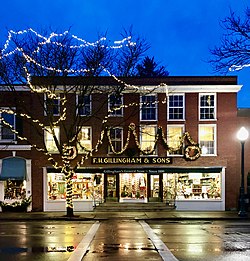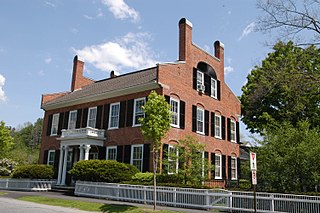
Woodstock is an incorporated village located within the town of Woodstock in Windsor County, Vermont, United States. As of the 2020 census, the village population was 900.

Woodstock is the shire town of Windsor County, Vermont, United States. As of the 2020 census, the town population was 3,005. It includes the villages of Woodstock, South Woodstock, Taftsville, and West Woodstock.

Hy-Vee is an employee-owned chain of supermarkets in the Midwestern and Southern United States, with more than 280 locations in Iowa, Illinois, Kansas, Minnesota, Missouri, Nebraska, South Dakota, Wisconsin, and soon Indiana, Kentucky, Tennessee, and Alabama. Hy-Vee was founded in 1930 by Charles Hyde and David Vredenburg in Beaconsfield, Iowa, in a small brick building known as the Beaconsfield Supply Store, which is listed on the National Register of Historic Places.

Frederick H. Billings was an American lawyer, financier, and politician. He is best known for his legal work on land claims during the early years of California's statehood and his presidency of the Northern Pacific Railway from 1879 to 1881.

A general merchant store is a rural or small-town store that carries a general line of merchandise. It carries a broad selection of merchandise, sometimes in a small space, where people from the town and surrounding rural areas come to purchase all their general goods. The store carries routine stock and obtains special orders from warehouses. It differs from a convenience store or corner shop in that it will be the main shop for the community rather than a convenient supplement.

Marsh-Billings-Rockefeller National Historical Park is a United States National Historical Park in Woodstock, Vermont. The park preserves the Marsh-Billings House, as well as the site where Frederick Billings established a managed forest and a progressive dairy farm. The name honors Billings and the other owners of the property: George Perkins Marsh, Mary Montagu Billings French, Laurance Rockefeller, and Mary French Rockefeller. The Rockefellers transferred the property to the federal government in 1992. It is the only unit of the United States National Park System in Vermont.

Franklin Swift Billings was an American businessman and politician from Woodstock, Vermont. He served as the 54th lieutenant governor of Vermont from 1923 to 1925 and as the 60th governor of Vermont from 1925 to 1927.

The S. H. Kress and Co. Building is a historic 1928 building in Tampa, Florida, United States. It was part of the S. H. Kress & Co. "five and dime" department store chain. The store closed in 1981, and has since remained vacant. on April 7, 1983, it was added to the U.S. National Register of Historic Places.
The Woodstock Railway was an intrastate railroad in southeastern Vermont. It ran from White River Junction, Vermont to Woodstock, Vermont, a distance of approximately 14 miles (23 km).

The George Perkins Marsh Boyhood Home, also known as the Marsh-Billings House, is the architectural centerpiece of Marsh-Billings-Rockefeller National Historical Park, on Vermont Route 12 in Woodstock, Vermont, United States. The house, built in 1805 and enlarged several times, is historically significant as the boyhood home of George Perkins Marsh (1801–1882), an early conservationist, and as the home later in the 19th century of Frederick H. Billings (1823–1890), a businessman and philanthropist who was a cofounder of the Northern Pacific Railroad. It is also architecturally significant as a high-quality example of Queen Anne architecture, alterations and enlargements commissioned by Billings and designed by Henry Hudson Holley. The house and its surrounding gardens were declared a National Historic Landmark in 1967. The 550-acre (220 ha) estate on which it stands was given by Mary French Rockefeller and Laurance Rockefeller to the people of the United States in 1992.

Franklin Swift Billings Jr. BEM was an American politician and judge from the state of Vermont. Billings served as Speaker of the Vermont House of Representatives, Chief Justice of the Vermont Supreme Court and Chief United States District Judge of the United States District Court for the District of Vermont.

Drug Fair was a chain of drugstores based in New Jersey.
Frederick Warren Stickney was an American architect.

Pakatakan Artists Colony Historic District is a national historic district located at Arkville in Delaware County, New York. The district contains 33 contributing buildings and two contributing structures built between 1886 and the 1960s. It consists of a small mountainside collection of studios and residences clustered about the original Pakatakan Lodge. It is an extremely well preserved collection of unusual Shingle Style and other wood frame seasonal buildings.

The Charles Marsh Law Office is a historic building at 72 Hartland Hill Road in Woodstock, Vermont. Now a private residence, this moved and altered structure, built about 1797, is the oldest surviving example of a detached law office in the state. It was built for lawyer Charles Marsh, and is where his sons George Perkins Marsh and Lyndon Arnold Marsh trained for and/or practiced law. The building was listed on the National Register of Historic Places in 1994.

The Reverend Dan Foster House is a historic house in Weathersfield, Vermont built in 1785 and expanded in 1825. It is part of the National Register of Historic Places designated Weathersfield Center Historic District.
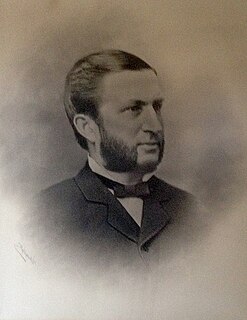
Franklin Noble Billings was a Vermont businessman and merchant. A member of the prominent Billings family, he was notable for his investment stakes and management roles in several Vermont businesses. He was the father of Governor Franklin S. Billings and grandfather of Judge Franklin S. Billings Jr. In addition, he was the brother of Frederick H. Billings, uncle of Mary Billings French, and grand-uncle of Mary French Rockefeller.
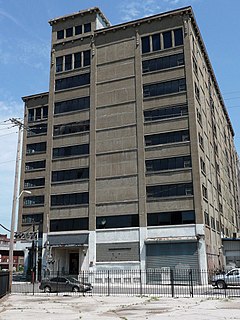
The Ridenour-Baker Grocery Company Building in Kansas City, Missouri is a commercial building constructed in 1910 by the Ridenour-Baker Grocery Company. It was the first wholesale grocery building west of the Mississippi River to be located on the path of a railway, where goods could be shipped into it directly. The building was listed on the National Register of Historic Places in 2014.
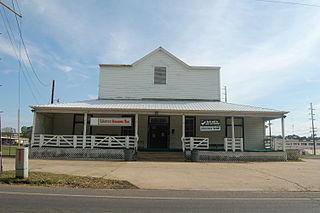
Caspiana Plantation Store is an American historic building and a former plantation store built in 1906, located at 1300 Texas Street in Natchitoches, Louisiana. The store served as part of the crop-lien system, during the time of sharecropping which impacted the lives of many African American workers.

